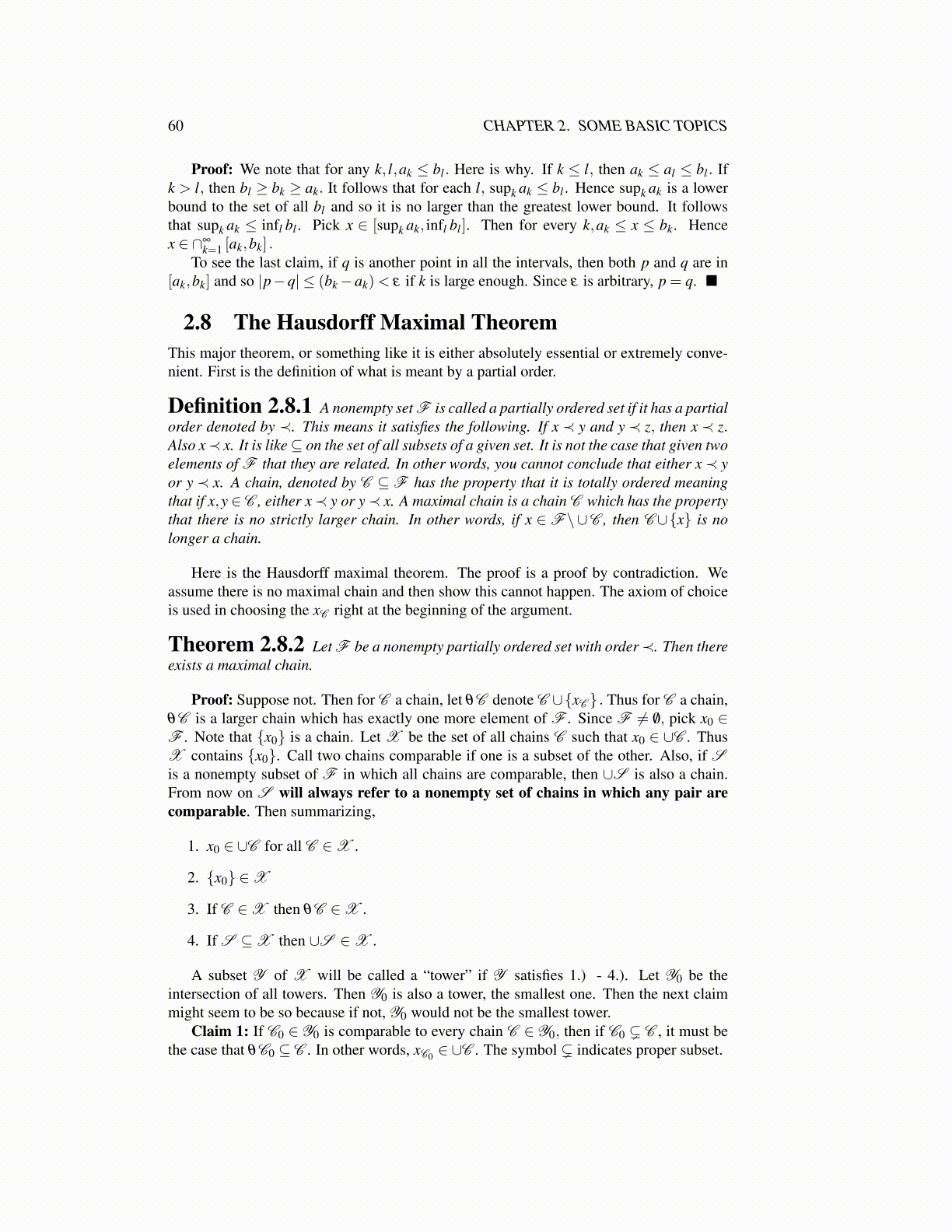
60 CHAPTER 2. SOME BASIC TOPICS
Proof: We note that for any k, l,ak ≤ bl . Here is why. If k ≤ l, then ak ≤ al ≤ bl . Ifk > l, then bl ≥ bk ≥ ak. It follows that for each l, supk ak ≤ bl . Hence supk ak is a lowerbound to the set of all bl and so it is no larger than the greatest lower bound. It followsthat supk ak ≤ infl bl . Pick x ∈ [supk ak, infl bl ]. Then for every k,ak ≤ x ≤ bk. Hencex ∈ ∩∞
k=1 [ak,bk] .To see the last claim, if q is another point in all the intervals, then both p and q are in
[ak,bk] and so |p−q| ≤ (bk−ak)< ε if k is large enough. Since ε is arbitrary, p = q. ■
2.8 The Hausdorff Maximal TheoremThis major theorem, or something like it is either absolutely essential or extremely conve-nient. First is the definition of what is meant by a partial order.
Definition 2.8.1 A nonempty set F is called a partially ordered set if it has a partialorder denoted by ≺. This means it satisfies the following. If x ≺ y and y ≺ z, then x ≺ z.Also x≺ x. It is like⊆ on the set of all subsets of a given set. It is not the case that given twoelements of F that they are related. In other words, you cannot conclude that either x≺ yor y ≺ x. A chain, denoted by C ⊆F has the property that it is totally ordered meaningthat if x,y ∈ C , either x≺ y or y≺ x. A maximal chain is a chain C which has the propertythat there is no strictly larger chain. In other words, if x ∈ F\∪C , then C∪{x} is nolonger a chain.
Here is the Hausdorff maximal theorem. The proof is a proof by contradiction. Weassume there is no maximal chain and then show this cannot happen. The axiom of choiceis used in choosing the xC right at the beginning of the argument.
Theorem 2.8.2 Let F be a nonempty partially ordered set with order≺. Then thereexists a maximal chain.
Proof: Suppose not. Then for C a chain, let θC denote C ∪{xC } . Thus for C a chain,θC is a larger chain which has exactly one more element of F . Since F ̸= /0, pick x0 ∈F . Note that {x0} is a chain. Let X be the set of all chains C such that x0 ∈ ∪C . ThusX contains {x0}. Call two chains comparable if one is a subset of the other. Also, if Sis a nonempty subset of F in which all chains are comparable, then ∪S is also a chain.From now on S will always refer to a nonempty set of chains in which any pair arecomparable. Then summarizing,
1. x0 ∈ ∪C for all C ∈X .
2. {x0} ∈X
3. If C ∈X then θC ∈X .
4. If S ⊆X then ∪S ∈X .
A subset Y of X will be called a “tower” if Y satisfies 1.) - 4.). Let Y0 be theintersection of all towers. Then Y0 is also a tower, the smallest one. Then the next claimmight seem to be so because if not, Y0 would not be the smallest tower.
Claim 1: If C0 ∈ Y0 is comparable to every chain C ∈ Y0, then if C0 ⊊ C , it must bethe case that θC0 ⊆ C . In other words, xC0 ∈ ∪C . The symbol ⊊ indicates proper subset.